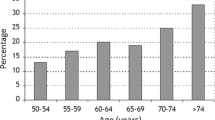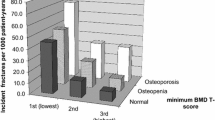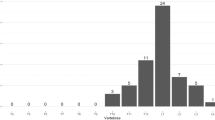Abstract
To test the hypothesis that the association between bone mineral density (BMD) and estimated volumetric BMD and prevalent vertebral fractures differs in men and women, we studied 317 Caucasian men and 2,067 Caucasian women (average age 73 years). A total of 43 (14%) men and 386 (19%) women had a vertebral fracture identified on lateral spine radiographs using vertebral morphometry. Hip and spine areal BMD was about 1/3 standard deviation lower among men and women with a vertebral fracture. A 0.10 g/cm2 decrease in areal BMD was associated with 30–40% increased odds of having a fracture in men and 60–70% increased likelihood in women. Low bone mineral apparent density (BMAD) was also associated with 40–50% increased odds of a vertebral fracture in both genders. The probability of a man having a fracture was observed at higher absolute areal BMD values than observed for women (P=values for interaction of BMD × gender: trochanter, P=0.05; femoral neck, P=0.10; total hip, P=0.09). In contrast, the probability of fracture was similar in men and women across the range of estimated volumetric BMD (BMAD). In conclusion, low BMD and low BMAD are associated with increased odds of vertebral fracture in both men and women. Measures of bone mass that partially correct for gender differences in bone size may yield universal estimates of fracture risk. Prospective studies are needed to confirm this observation.

Similar content being viewed by others
References
Melton LJD, Chrischilles EA, Cooper C, Lane AW, Riggs BL (1992) Perspective. How many women have osteoporosis? J Bone Miner Res 7:1005–1010
Merrill RM (1997) The lifetime risk of developing prostate cancer in white and black men. Cancer Epidemiol Biomarkers Prev 6:763–768
NIH Osteoporosis Prevention, Diagnosis and Therapy. NIH Consensus Development Conference (2000) Bethesda, MD
Kanis JA (2002) Diagnosis of osteoporosis and assessment of fracture risk. Lancet:1929–1936
Selby PL, Davies M, Adams JE (2000) Do men and women fracture bones at similar bone densities? Osteoporos Int 11:153–157
Cheng SL, Suominen H, Sakarirantala R, Laukkanen P, Avikainen V, Heikkinen E (1997) Calcaneal bone mineral density predicts fracture occurrence—a 5-year follow-up study in elderly people. J Bone Miner Res 12:1075–1082
Ross PD, Lombardi A, Freedholm D (1999) The assessment of bone mass in men. In: Orwoll ES (ed) Osteoporosis in men: the effects of gender on skeletal health. Academic Press, San Diego, pp 505–552
Van Der Klift M, De Laet C, McCloskey E, Hofman A, Pols HA (2002) The incidence of vertebral fracture in men and women: the Rotterdam Study. J Bone Miner Res 17:1051–1056
The European Prospective Osteoporosis Study EG (2002) The relationship between bone density and incident vertebral fracture in men and women. J Bone Miner Res 17:2214–2221
Orwoll E (2000) Assessing bone density in men. J Bone Miner Res 15:1867–1870
Melton LJ, Atkinson EJ, O’Connor WK, O’Fallon WM, Riggs L (1998) Bone density and fracture risk in men. J Bone Miner Res 13:1915–1923
Carter DR, Bouxsein ML, Marcus R (1992) New approaches for interpreting projected bone densitometry data. J Bone Miner Res 7:137–145
Cummings SR, Nevitt MC, Browner WS, et al (1995) Risk factors for hip fracture in white women. Study of the Osteoporotic Fractures Research Group. N Engl J Med 332:767–773
Glynn NW, Meilahn EN, Charron M, Anderson SJ, Kuller LH, Cauley JA (1995) Determinants of bone mineral density in older men. J Bone Miner Res 10:1769–1777
Black DM, Cummings SR, Stone K, Hudes E, Palermo L, Steiger P (1991) A new approach to defining normal vertebral dimensions. J Bone Miner Res 6:1991
Faulkner KG, Gluer CC, Estilo M, Genant HK (1993) Cross-calibration of DXA equipment: upgrading from a Hologic QDR 1000/W to a QDR 2000. Calcif Tissue Int 52:79–84
Katzman DK, Bachrach LK, Carter DR, Marcus R (1991) Clinical and anthropometric correlates of bone mineral acquisition in healthy adolescent girls. J Clin Endocrinol Metab 73:1332–1339
Collaboration (2000) Older Americans 2000: Key indicators of well-being. Federal Interagency Forum on aging-related statistics, pp 1–113
Orwoll E, Ettinger M, Weiss S, et al (2000) Alendronate for the treatment of osteoporosis in men. N Engl J Med 343:604–610
Binkley NC, Schmeer P, Wasnich RD, Lenchick L (2002) What are the criteria by which a densitometric diagnosis of osteoporosis can be made in males and non-caucasians? J Clin Densitomerty 5:S19–S27
Nguyen T, Sambrook P, Kelly P, Jones G, Lord S, Freund J (1993) Prediction of osteoporotic fractures by postural instability and bone density. BMJ 307:1111–1115
Nyquist F, Gardsell P, Sernbo I, Jeppsson JO, Johnell O (1998) Assessment of sex hormones and bone mineral density in relation to occurrence of fracture in men: a prospective population-based study. Bone 22:147–151
Gardsell P, Johnell O, Nilsson BE (1990) The predictive value of forearm bone mineral content measurements in men. Bone 11:229–232
Kroger H, Lunt M, Reeve J, Dequeker J, Adams JE, Birkenhager JC, Diaz Curiel M, Felsenberg D, Hyldstrup L, Kotzki P, Laval-Jeantet AM, Lips O, Perez Cano R, Reiners C, Ribot C, Ruegsegger P, Schneider P, Braillon P, Pearson J (1999) Bone density reduction in various measurement sites in men and women with osteoporotic fractures of spine and hip: The European Quantitation of Osteoporosis Study. Calcif Tissue Int 64:191–199
O’Neill TW, Felsenberg D, Varlow J, Cooper C, Kanis JA, Silman AJ (1996) The prevalence of vertebral deformity in European men and women: The European Vertebral Osteoporosis Study. J Bone Miner Res 11:1010–1018
Cooper C, O’Neill T, Silman AJ (1993) The epidemiology of vertebral fractures. Bone 14:S89–S97
Cauley JA, Zmuda JM (1999) Risk factors for fracture in men. In: Orwoll ES (ed) Osteoporosis in men: the effects of gender on skeletal health. Academic Press, San Diego, pp 363–393
Wasnich RD (1996) Vertebral fracture epidemiology. Bone 18:179S–183S
Duan Y, Parfitt A, Seeman E (1999) Vertebral bone mass, size and volumetric density in women with spinal fractures. J Bone Miner Res 14:1796–1802
Seeman E, Duan Y, Fong D, Edmonds J (2001) Fracture site-specific deficits in bone size and volumetric density in men with spine or hip fractures. J Bone Miner Res 16:120–127
Acknowledgements
This study was supported in part by Public Health Service research grants from the National Institutes of Health: AR35582, AR44811 and AG05407.
Author information
Authors and Affiliations
Corresponding author
Rights and permissions
About this article
Cite this article
Cauley, J.A., Zmuda, J.M., Wisniewski, S.R. et al. Bone mineral density and prevalent vertebral fractures in men and women. Osteoporos Int 15, 32–37 (2004). https://doi.org/10.1007/s00198-003-1462-8
Received:
Accepted:
Published:
Issue Date:
DOI: https://doi.org/10.1007/s00198-003-1462-8




